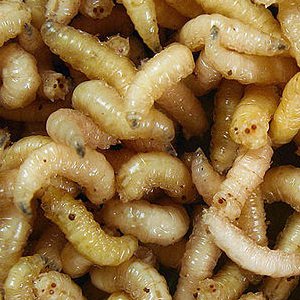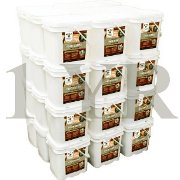 Do you know what you are eating? Most Americans simply do not understand that the FDA actually allows rat excrement, maggots and insect heads to be put into their food. The FDA only allows a small amount of these things, but they do explicitly allow them. You don't believe this? Well, you can read it for yourself. The FDA has published a pamphlet entitled “The Food Defect Action Levels: Levels of Natural or Unavoidable Defects in Foods That Present No Health Hazards for Humans” that tells food producers exactly how many "natural contaminants" are allowed in our food. The following are just some examples of the allowable levels of "natural contaminants" that the FDA lists in the pamphlet.....
Do you know what you are eating? Most Americans simply do not understand that the FDA actually allows rat excrement, maggots and insect heads to be put into their food. The FDA only allows a small amount of these things, but they do explicitly allow them. You don't believe this? Well, you can read it for yourself. The FDA has published a pamphlet entitled “The Food Defect Action Levels: Levels of Natural or Unavoidable Defects in Foods That Present No Health Hazards for Humans” that tells food producers exactly how many "natural contaminants" are allowed in our food. The following are just some examples of the allowable levels of "natural contaminants" that the FDA lists in the pamphlet.....
Canned Citrus Juices (such as orange juice) - 5 or more Drosophila and other fly eggs per 250 ml or 1 or more maggots per 250 ml
Cornmeal - Average of 25 or more insect fragments per 25 grams
Cranberry Sauce - Average mold count of 15%
Fig Paste - 13 or more insect heads per 100 grams of fig paste
Macaroni And Noodle Products - Average of 225 insect fragments or more per 225 grams
Mushrooms - Average of over 20 or more maggots of any size per 100 grams of drained mushrooms
Crushed Oregano - Average of 300 or more insect fragments per 10 grams
Peanut Butter - Average of 30 or more insect fragments per 100 grams
Spinach - Average of 50 or more aphids, thrips and/or mites per 100 grams
Tomato Paste, Pizza And Other Sauces - Average of 30 or more fly eggs per 100 grams OR 15 or more fly eggs and 1 or more maggots per 100 grams
Wheat - Average of 9 mg or more rodent excreta pellets and/or pellet fragments per kilogram
Are you starting to get the picture?
We don't know about you, but we do not want ANY insect heads in our fig paste.
But, oh boy, if there is a 14th insect head in 100 grams of fig paste THEN the food producers get into big trouble.
No wonder so many people are getting sick from their food.
Even the ingredients in our food supply that are supposedly "safe" have been found to be quite the opposite.
Remember all those commercials recently that told us how safe and wonderful high fructose corn syrup is?
Well, it turns out that definitely is not the case after all.
In one stunning new study, almost half of the tested samples of commercial high fructose corn syrup contained significant levels of mercury. In addition, the same study found mercury in almost a third of 55 popular brand name food and beverage products where high fructose corn syrup is the first or second listed ingredient.
If you are not familiar with high fructose corn syrup, you should be. It is in thousands of our food and beverage products.
Go into your refrigerator and look at how many products it is in.
And the truth is that it is chock full of mercury.
You see, mercury is a highly toxic heavy metal.
Among other things, mercury can cause serious brain damage, deafness and blindness. It is incredibly harmful for humans.
But it tastes so good!
And who cares if there are insect fragments in our peanut butter?
After all, it tastes so great on a piece of toast!
The truth is that we live in a society where it is hard to trust anyone or anything.
In the past we could eat dinner without any worries, but we are moving into a time when we are going to have to think very carefully about what we are putting into our bodies. Please be sure that you are putting safe, healthy food products into your emergency food supply.

























So why is the phrase “natural contaminants” in “scare quotes” throughout this incredibly “informative” article? Have rat excrement and bug parts been reclassified recently as synthetic adulterants?
People have been eating rat excrement and bugs for, well, pretty much the entire history of the human race, as have all of our predecessors, as have almost every species on the face of the planet. And you can be guaranteed that before the advent of pasteurization, sanitization and processing technologies, people were eating rat excrement at far greater quantities than 9 ppM.
Our entire biosphere depends upon excrement and death, and it is EVERYWHERE.
This is what an immune system is for, and if anything, we should be getting more bug parts and coliform bacteria into our bodies.
Eat what you want, preferably out of the ground rather than out of a box (keeping in mind that you’re going to be eating more bugs and excrement from whole foods than processed foods), practice some basic hygiene, and quit being such a bunch of nervous hypochondriacs.
You were dead on about corn syrup though, that stuff will mess you up but good.
No wonder the organic health movement in America is gaining so much steam. If almost nobody knows about the super-secret food defect allowances like you say, then how could it possibly be a significant reason that more people are buying organic food? Even the ingredients in the American food supply that are supposedly “safe” have been found to be quite the opposite.
y be a significant reason that more people are buying organic food? Even the ingredients in the American food supply that are supposedly “safe” have been found to be quite the opposite.
You do realize that this ends up in all food, everywhere. Because bugs need to eat too. And it just so happens that a lot of them like the same foods that WE do. Stop trying to scare people, you’re just as bad as the news. Oh, and organic foods? Expect them to have more bug parts. Because pesticides are disallowed. Just stop. You fail at being provocative.